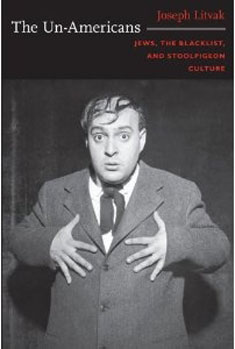Stoolpigeons and Patriots
A fresh look at the Cold War era, when left-leaning Jews were quickly labeled as un-American
By Helene Ragovin
In 1947, the House Un-American Activities Committee opened an inquiry into purported communist influence in the motion picture industry. Scores of Hollywood actors, directors, screenwriters and others were called before HUAC, as it was known, and asked both to prove their loyalty and to disclose the names of their friends and associates whose sympathies were suspect.

“One of the things I’m interested in is how American identity is about acting—you become an American by acting like an American,” says Joseph Litvak. Photo: Alonso Nichols
That, in turn, set the stage for the Hollywood blacklist: a roster of hundreds who were banned from working in film, television and, to a lesser extent, theater. The blacklist destroyed careers and lives. Earning a spot on the list required little more than having a “friendly witness” dangle your name before HUAC.
Watching those hearings on snippets of grainy black-and-white newsreels more than 60 years later, they seem almost quaint—a Cold War relic. Yet, argues Tufts English professor Joseph Litvak, the spirit of the blacklist is alive and well today, in a social and political landscape where the term “un-American” is still used to smear and disparage.

Litvak is the author of The Un-Americans: Jews, the Blacklist, and Stoolpigeon Culture (Duke University Press, 2009), a look at the Cold War era and its enduring cultural and political legacy. Specifically, the book examines the role that a particular strain of anti-Semitism—both in Hollywood and Washington—played during the time.
“Six of the Hollywood Ten, the first uncooperative witnesses—all of whom were imprisoned as well as blacklisted—were Jews,” Litvak writes. A non-Jew among the Hollywood Ten “was accused of ‘writing like a Jew’ and Jews made up an overwhelmingly large percentage of the witnesses (both ‘friendly’ and ‘unfriendly’) who appeared before the committee.”
“Yet the aim of this book is not to belabor the obvious (and well-established) point that HUAC, like many ‘anti-communist’ entities, was motivated by anti-Semitism,” Litvak continues. Rather, the book focuses what Litvak terms “comicosmopolitanism”—the perception that Jewishness “embodies not just the comic, but the whole scandalous, indeed criminal, conspiracy of smartness, acting, pleasure, happiness, imitation, mobility and play, centered in yet reaching well beyond Hollywood and New York.” In other words, behavior that was inherently “un-American.”
Litvak began working on the book around the time of 9/11, “when we started to see increased attention to, and anxiety about, who is ‘American’ and who is ‘un-American,’ ” he says. “It seemed to me we were suddenly back in the 1950s, and all you had to do was substitute ‘terrorist’ for ‘communist.’ ”
“While the book seems to be about the period of 1947 to roughly 1964,” says Litvak, “in fact, I think it’s a book about the way we live now.”
Tufts Journal: What do you mean by “stoolpigeon culture”?
Joseph Litvak: A stoolpigeon is an exemplary citizen. It seems strange—why would a stoolpigeon be an exemplary citizen? It’s such a nasty word, for one thing; no one wants to be called a stoolpigeon. But what I argue in the book is that, surprisingly, the stoolpigeon is what every good citizen was expected to be, and to some extent is still expected to be. I would argue we’re still living in stoolpigeon culture. We’re still expected to inform; we’re still expected to look with suspicion upon strangers, or strangeness.
The irony is that totalitarian regimes operate through networks of informers, and democratic societies are not supposed to. Yet American society did operate as a society of informers in the 1950s and after.
The HUAC hearings started in 1947, just two years after the end of World War II and shortly after the world learned the full extent of the Nazi genocide against the Jews. Yet Jews became the primary victims of the blacklist. What do you make of that? And what was the response of the mainstream American-Jewish community at the time?
One of the horrible ironies of this phenomenon is that having defeated fascism in Europe, we brought it back home and adapted it for domestic use. In a sense we were repeating anti-Jewish fascist totalitarianism, the very thing we had supposedly defeated in Europe just a few years earlier.
The response by the American-Jewish community? The most general answer is that the [mainstream] American-Jewish community did not want to touch the Jewish left with a 10-foot pole. The American-Jewish community was as anxious as Hollywood and the left in general [about being blacklisted], and wished to dissociate itself as much as possible from—and here we really need quotation marks—“bad Jews” who threatened to give the American-Jewish community a bad name. The ’50s was an anxious decade, a time of assimilation. It was only a few years removed from what we now call the Holocaust, but was then only [called] “the War,” as though to speak of genocide, to speak of anti-Semitism, were itself to revive it. The community wanted to define itself as American, and not as Jewish, and therefore vulnerable.
There are exceptions, and one doesn’t want to judge harshly those who were indeed living through difficult circumstances themselves. Most of the time people don’t behave heroically—which is not to say there weren’t heroes in this period.
The blacklist doesn’t receive much attention as an episode in contemporary American history. What is its legacy?
One reason why I wrote the book is I think a lot of people don’t know the story, and don’t know we’re still living through it—for example, the current tendency to withdraw civil liberties in the interest of security.
The HUAC hearings were also part of another story that’s still playing out, the destruction of the New Deal and Roosevelt’s legacy—the attempt to take back America for so-called Americans; to take back America from the [political] left and the various minorities with whom the left had been associated. And we see this going on today, this indignation on the part of those who feel America has been taken away from them, who see Obama as a kind of second Roosevelt, and who feel their identities as Americans have been confiscated.
Most people say they are surprised when they read this book, and I wrote it to surprise—and also to teach, since I am a teacher, after all. I’d like to get people to think about the forces that continue to shape us in our everyday lives. One of the things I’m interested in is how American identity is about acting—you become an American by acting like an American. There is a whole set of unwritten rules about acceptable and unacceptable national behavior. So we’re all actors in a sense.
Any time you go out into the world, any time you have an interaction with an authority figure, you’re either consciously or unconsciously acting the good citizen, if you know what’s good for you. One acts the role of the good American, even without knowing it, or especially without knowing it. That’s what movies and television are for, after all, which is why HUAC was so eager to police them.
At first glance, this seems like a book that would come from someone with a specialization in history or political science. How did you, a professor of English, come to the subject?
This book is a bit of a departure for me, because I was trained as a scholar of 19th-century literature. But I was working on related topics: acting and deviance. In this case, it was deviance of a political kind, mechanisms to correct and punish the seductive deviance of those outside the norm. Here it was Jews with left-wing political affiliations. These were the typical victims of the blacklist: Jewish communists, Jewish left-wing intellectuals and merely Jewish liberals. You didn’t have to be a communist to get into trouble with HUAC. You only had to be perceived as a so-called fellow traveler on the left or have liberal sympathies.
Helene Ragovin can be reached at helene.ragovin@tufts.edu.


